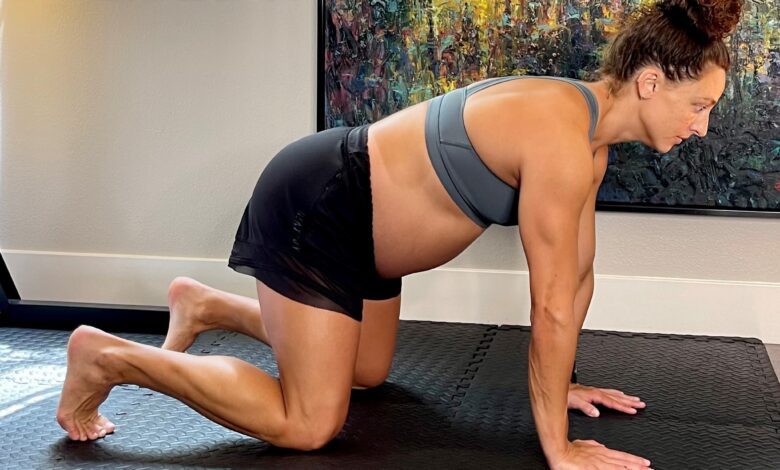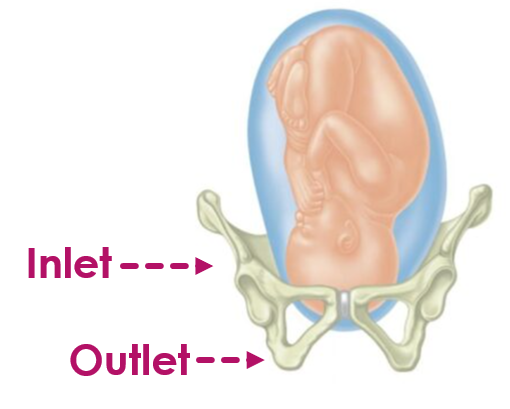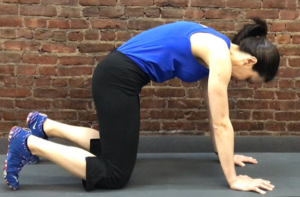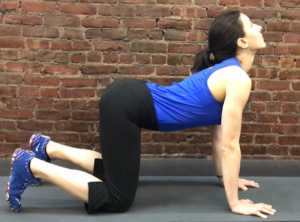Mobility Exercises to Prepare for Birth

There are many helpful exercises that can help you prepare for various aspects of birth — including breathing, energy system training, push up training, and in general strength training. This article focuses on that in particular mobility exercises which will help make labor easier (for you and your baby).
First, we will look at what positions during childbirth help facilitate the movement of the baby through the birth canal. Then, we’ll share specific mobility exercises you can practice today to make sure you’re comfortable access positions during labor.
The Key to Baby Movement = SPACE in the Pelvis
The journey through the birth canal is no a straight road. You can see it in the picture below. Notice how the baby’s head is not aligned with the vaginal opening. Therefore, in order to get out, the human baby has to perform a series of complex movements (known as the cardinal movements).
Amazingly, babies are essentially programmed to perform these movements, but they need SPACE to do so. If we can maximize the amount of space a baby has inside the pelvis, we can not only speed up this process, but also reduce the stress on the muscles and tissues inside the pelvic bowl (and therefore reduce the risk of injury ).
So, how do we create space in the pelvis?
How to Create the Largest Space in Your Pelvis
First, it is important to understand how the baby moves in the pelvis. In the early stages of labor, the baby begins to top of the pelviscalled the entering As labor progresses, the baby moves through the center of the pelvis and then out of the under the pelviscalled the exit.


You can help create this space with two basic pelvic movements: Tucking and Untucking
“Squeezing” helps Expand the Pelvic INLET
Think of the “cat” part of the cat-cow below. Placing the pelvis under – with outward rotation of your hips so that your knees are wider than your feet — creating a larger space at the top of the pelvis (inlet).


“Untucking” Helps Expand the Pelvic OUTLET
Now, imagine the “cow” part of the cow-cat below. Removing the pelvis – including internally rotating your hips so that your knees are closer together than your feet — creating a larger space under the pelvis (outlet).


Movement Exercises to Prepare the Pelvis for Childbirth
Now that you understand squeeze and untucked (and internal and external rotation in your hips) during the different stages of birth is key to creating space, the mobility exercises below will help you practice these different positions. You do NOT need to worry when to perform tucking or untucking during your delivery. Your midwife, doula, nurse, or other professional can help with this guide. The important thing you focus on is making sure you can access these positions when necessary by conducting mobility preparations. That’s how the exercises below can help.
NOTE: For all the exercises below, it is very important breathe comfortably in all positions. This lets your brain know the position is safe, allowing your tissues to fully relax so you can get the most out of your mobility work.
- Windshield Wiper: This strengthens your thighs to move wide and narrow, or internal and external rotation (knees wider than feet, and then knees closer than feet).
- Frog with Foot Lift-Off: This move takes Windshield Wipers to the next level by activating the hip rotators at their end ranges.
- Cat Pose with Knees Wider Than Feet: This is the pelvic inlet opener we talked about above — squeezing the pelvis with help from extending the thighs (knees wider than feet).
- Deep Squat with Wide Knees: This is another pelvic inlet opener. It may be more difficult to keep your feet narrow in this position, so work with the range you have.
- Happy Baby Pose: This is another pelvic inlet opener because it involves squeezing the pelvis. You can play with the width of the knees in relation to the feet. Plus, it just feels good and a preview of what you’ll see your baby do in a few months😊.
- Cow Pose With Knees Closer Than Feet: This is the pelvic outlet opener we talked about above — removing the pelvis with help from narrowing the thighs (the knees are closer than the feet).
- Supported Hinge with Knees Closer Than Feet: This is another great “untucking” movement that helps open the pelvic outlet.
More Preparation and Recovery Resources
For safe and effective workouts that will help you prepare your body for pregnancy and birth, then recover more effectively, explore our pre and postnatal self-guided training programs. Or, for a more personalized approach, visit our Find a Coach page to work with one of our expert coaches.
Interested in Becoming PROnatal Certified?
Are you a fitness or health professional interested in coaching pre and postnatal clients? Explore our Pre & Postnatal Professional Education. We offer in-depth education to become Pronatal Certified for those seeking to specialize in training in this population, and a mini course for group fitness instructors which only requires basic knowledge.





